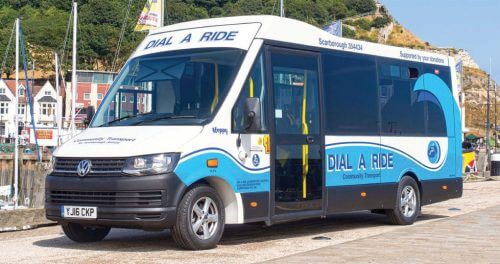
VW Transporter T6 forms the base for the company’s overhauled vehicles, which can offer 15 passenger seats or four wheelchair spaces on a low-floor vehicle.
Mellor Coachcraft’s model range revision has continued, with a complete redesign of its low-floor Tucana, the Tucana II, with a number of major design changes. The Tucana II has been completely re-engineered for Volkswagen’s Transporter T6 base vehicle, and Mellor Coachcraft has called it a re-imagining of the original concept.
The front of the vehicle has been redesigned with new CAD (Computer Aided Design) mouldings to complement the T6 styling, and new interior mouldings have been included in the driver and passenger areas. Like its predecessor, the saloon of the Tucana II – which has a flat floor throughout – is capable of having 15 passenger seat positions. However, it can now carry up to four wheelchairs without the need for a passenger lift. Wheelchairs can be loaded through the front or rear doors via ramps, thanks to the 270mm floor height.
The Euro 6 vehicle offers a four-cylinder 1968cc engine, coupled to either a six-speed manual or seven-speed automatic gearbox. The gross vehicle weight is 4,100kg, with a length of seven metres.
The Tucana II has the same, wide powered sliding door as fitted to the recently-launched Mellor Strata, offering a closer kerbside approach than the swing-out plug doors which have been replaced. The vehicle can have rear doors and a bi-fold ramp or a coach back, and Mellor Coachcraft has said it can have destination equipment and a ticket platform if required. “The original Tucana was designed in 2004 and exhibited at the CTA show at G-MEX in 2005,” recalled Mellor Coachcraft General Manager John Randerson. “It was very successful, selling 600 vehicles.
“The arrival of the Volkwagen T6 necessitated a redesign, so our engineering team at the Scarborough facility has taken the opportunity to completely revise Tucana from the floor upwards. “Once again, our efforts have been directed into creating a cost-effective, reliable low-floor minibus which we believe provides passengers with an environment that is best in class.”
An approved Volkswagen coachbuilder, Mellor Coachcraft has retained only the Volkswagen front wheel drive system, dashboard and rear braking components. The body frame is a lattice structure in stainless steel, with aluminium side panels but GRP (Glass Reinforced Plastic) mouldings elsewhere. The bespoke trailing-arm suspension at the rear is now being coil sprung, as are the front axles. Air suspension for the rear trailing arms to lower the rear step height further is also an option.
John continued: “The previous version of the Tucana was extremely popular, but the plug doors could be problematic in service. These have now been replaced with the Ventura sliding door which is now common across our range.
“It brings the added advantage of requiring almost no kerb gap to operate, so is less susceptible to damage and allows easier
passenger boarding.
“The changes have also improved the view to the wing mirrors through the fitment of larger front quarter lights.”
The layout in the first production sample incorporates a new space-saving tip-and fold seat, jointly designed by Mellor Coachcraft and Rescroft of Redditch. The tracked fully-flat floor – like all other Mellor Coachcraft low-floor buses – is made from rot-free composite instead of plywood. This can be configured to suit the customer.
A choice of seating includes Rescroft, Phoenix or Kiel Ligero bus seats. The rear ramp on the vehicle is again the Portaramp design which is seen on other Mellor models:
“We have built good relationships with a stable supply chain,” added John. ????This ensures we have excellent partnerships that enable us to improve our products, these partnerships lead to exemplary product knowledge and spares supply.”
Heating and ventilation can be configured in a variety of patterns with units supplied by Eberspächer and Webasto, with roof-mounted air-conditioning available at up to 12kW in capacity
“The Tucana II has a level of robustness which makes it more than adequate for most applications including some light stage carriage activity,” concluded John. “Though fare-stage service isn’t its target market, this design and build quality will deliver the benefits of affordability, low fuel cost and all around reliability for any operator.”

